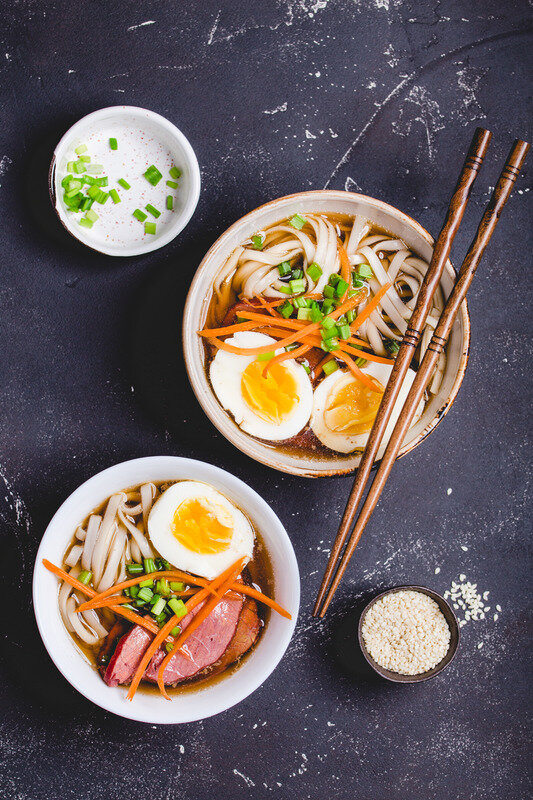Is Miso Ramen Vegan? (3 Tips For Weight Loss)
Miso Ramen is one of the tastiest types of Ramen that Japanese cuisine has to offer.
It’s full of complex flavors which come from the addition of Miso Paste and different aromatic vegetables.
Although Miso Ramen is delicious, is it vegan?
Miso Ramen can be vegan but the addition of chicken or beef stock along with eggs and pork is what keeps it away from a vegan diet.
If you want to make a Vegan Ramen, then you must create your own vegetable stock in place of the chicken or beef stock typically used.
We will also go over some tips on how you can eat Ramen and still stay fit and healthy.
Here are three steps to make your Miso Ramen vegan and to stay healthy while eating some of our favorite noodle dishes.
Understand Which Ingredients Need To Be Substituted
Understand How Many Calories Goes Into Vegan Miso Ramen
Understand How Many Calories You Need To Eat In a Day
Now that we know our three steps, let’s get into the details on how we can enjoy some Ramen while staying lean and mean.
Tip 1: Understand Which Ingredients Need To Be Substituted
Ramen is typically made with pork bones and chicken cartilage as the browning of these ingredients creates a fond which flavors the soup base.
However, the real flavor of the dish comes from many different aromatic vegetables such as garlic, shallots, carrots, parsnip and green onions.
The addition of pork or chicken is unnecessary which makes Miso
Ramen a perfect dish to enjoy as someone who eats vegan.
We just simply need to take out a few ingredients and see where some substitution is required.
Let’s take a look at the three components we need to substitute.
Soup Base:
As mentioned above, Ramen soup bases tend to use pork bones and chicken cartilage to flavor the broth.
However, using a vegetable broth filled with aromatic vegetables can do just fine, if not better.
Here is an awesome recipe for a vegetable broth that we use when we want to cook up a nice soup or noodle dish without the use of meat.
Vegetable Broth Recipe:
1 Whole Spanish Onion
2 Shallots
3 Green Onions
¼ Parsnip
1 Head Garlic
1 Piece Ginger (small)
1 Daikon Radish
Here is a recipe you can use but simply replace the Pork or Chicken broth with this broth. (1)
I’ve used this recipe before for both vegan and non vegan Miso Ramen dishes and they’ve worked out perfectly.
Give it a try with our vegetable stock and see how it tastes!
Toppings:
You can usually expect Ramen to have a lot of thick slices of Char Siu on top which can be both fattening and non vegan.
The trick here is to find “meaty” vegetables like shiitake or portobello mushrooms that can act as a great substitute.
Our favorite way to cook these up is to simply grill them or saute them in a pan.
You can also add some bamboo shoots for a bit of a crunch and some green onions to add some color to the dish.
Tofu is also a great option as it soaks up the soup base really well which is always a welcomed trait.
Be creative with this and come up with some of your favorite veggies that can act as a topping!
Noodles:
Most Ramen noodles use alkaline salt, flour, and water in their noodle mix so you’ll be fine if you simply make sure that these are the three basic ingredients.
However, there are some places that use egg in the noodles to add a bit of a chew so make sure that you are getting alkaline noodles when eating Ramen.
Making Ramen noodles at home can be a fun experiment and will ensure that you get an awesome Vegan meal as you are in control of the ingredients.
Here is a recipe for alkaline noodles that you can try to make at home for yourself. (2)
So, now that we know of the three components of Ramen and how we can adjust some ingredients to make it vegan,
let’s take a look at how we can ensure a healthy diet while eating our favorite Ramen dish.
Tip 2: Understand How Many Calories Goes Into Vegan Miso Ramen
A healthy diet means that there is balance within the three macronutrients.
Understanding the calorie content of certain foods means that we are in control of this balance and get to decide what macronutrients we put into our diet.
The goal of this entire blog is to show the calorie contents of certain foods that might be ambiguous or hard to find.
This way, we can add them into our diet as we are aware of what they offer nutritionally.
Let’s take a look at the calories for a Vegan Miso Ramen and see what it gives us.
For every 8 grams of fat, we get 36 grams of carbs and 7 grams of protein.
The issue with this dish is the ratio between fats and protein.
You can see that there are more grams of fat than there are grams of protein which means that there is high potential to overeat with this dish.
Fat is the highest caloric macronutrient out of the three which means that it should be the lowest number in terms of grams.
A gram of fat is 9 kcals while a gram of carbs or protein is 4 kcals.
We always want to make sure that our proteins are higher than our fats as having a diet with a surplus of fats can lead to fast weight gain and some complications down the line.
Let’s also compare the carbs to the amount of protein we get.
We can see that there are 36 grams of carbs for every 7 grams of protein.
This means that the majority of calories in this dish come from fats and carbs while the minority stands with protein.
A good balance of macronutrients is a mixture of a certain percentage.
We generally want to be eating around 34% protein, 45% carb, and 21% fats.
This dish will make it very difficult to get our protein which can slow fat loss and inhibit results.
Our tip here is to top the dish with some high protein items such as Tofu or Edamame.
These go great with ramen and offer protein to the dish.
Tofu has a whopping 8 grams of protein per 3 oz. serving with 4 grams of fat and 2 grams of carbs.
This will definitely help the balance of the three macronutrients and offer the nutrition that we need.
Overall, it’s a dish that is not bad to eat but it should be eaten in moderation.
Enjoy it on your cheat days or when you’re a nice warm bowl of Ramen and you can get your Ramen fix in while staying on track with your diet.
Tip 3: Understand How Many Calories You Need To Eat In a Day
Understanding your daily allotted calories is a crucial step in determining how you look and feel.
The American diet often encourages weight gain as calories are really ambiguous with so many different foods.
However, it can be combated by understanding the importance of calories and getting the correct number of calories you need to eat in a day.
There are really two methods to discover your calorie ranges for each day.
The first is to use an online TDEE (Total Daily Energy Expenditure) calculator and choose either goal you want or, if your goal is weight loss, a simple equation of multiplying your bodyweight by 12 would suffice.
Keep in mind that these are both very inaccurate methods but will give you a great place to start.
There will be adjustments involved in this process so some patience will be required.
After getting this number from either method, the key here is to either subtract or add calories until you find that sweet spot.
Let’s take a 130 pound female for example.
The equation gives us the number 1,560 kcals per day which can either be too little, too much, or just right.
If the calories are too little (she loses more than 2 pounds a week) then adding 100 or 200 calories would be beneficial.
If the calories are too much (she gains weight or does not lose any), then she should drop the calories by 100-200 per week.
Slow and steady wins the race when discovering this number so take your time and find that sweet spot where you can lose a pound of fat in a week.
If you want a more in-depth article on the entire process of discovering your calories and the certain workouts you need to get to your goals, then check out this article where we go over the details!
https://www.aspirefitnesswalnut.com/how-to-actually-get-a-six-pack-after-30
There’s really five steps you need to take when you think about weight loss and getting lean so make sure to check out this article if you’re interested in getting your numbers straight!
There It Is!
In this article we went over how we can enjoy our favorite Ramen dish while staying within a Vegan diet.
We also went over the importance of understanding the calories in certain foods and the allotted calories each individual should eat.
If you’re interested in more information of Asian foods and fitness tips, then make sure to check out our other articles where we go over all of your favorites!
RECENT POSTS
The Asian Weight Loss Cookbook
The 15 Fat Burning Meals Cookbook features our favorite recipes that you can use to get closer to your fitness goals.
Become your own personal trainer with the guidance of this book and make this the year you achieve your insurmountable fitness goals.
PHILLIP PAK
Phillip Pak is a fitness expert who has been training clients for 6 years. Throughout his fitness journey, Phill has done it all when it comes to diet and nutrition. He is now the owner of Aspire Fitness Walnut where his main goal is to help those who are seeking to find the best version of themselves. Phillip is also a NASM Certified Nutrition Coach (CNC) and a NASM Certified Personal Trainer (CPT).














